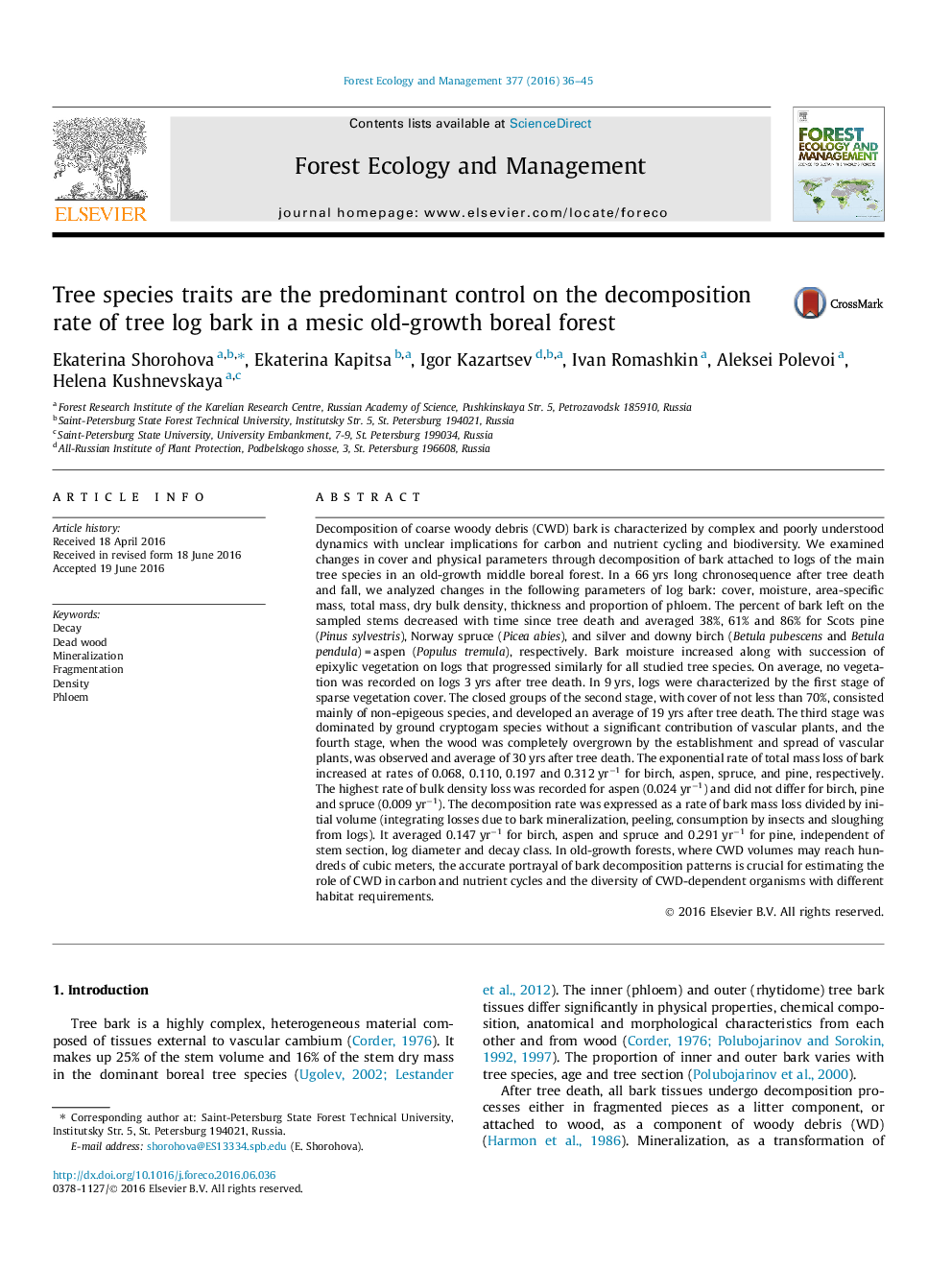| کد مقاله | کد نشریه | سال انتشار | مقاله انگلیسی | نسخه تمام متن |
|---|---|---|---|---|
| 6542065 | 159146 | 2016 | 10 صفحه PDF | دانلود رایگان |
عنوان انگلیسی مقاله ISI
Tree species traits are the predominant control on the decomposition rate of tree log bark in a mesic old-growth boreal forest
ترجمه فارسی عنوان
صفات گونه های درختی کنترل غالب بر میزان تجزیه درختان درخت در جنگل های قدیمی جنگل های بومی
دانلود مقاله + سفارش ترجمه
دانلود مقاله ISI انگلیسی
رایگان برای ایرانیان
کلمات کلیدی
موضوعات مرتبط
علوم زیستی و بیوفناوری
علوم کشاورزی و بیولوژیک
بوم شناسی، تکامل، رفتار و سامانه شناسی
چکیده انگلیسی
Decomposition of coarse woody debris (CWD) bark is characterized by complex and poorly understood dynamics with unclear implications for carbon and nutrient cycling and biodiversity. We examined changes in cover and physical parameters through decomposition of bark attached to logs of the main tree species in an old-growth middle boreal forest. In a 66Â yrs long chronosequence after tree death and fall, we analyzed changes in the following parameters of log bark: cover, moisture, area-specific mass, total mass, dry bulk density, thickness and proportion of phloem. The percent of bark left on the sampled stems decreased with time since tree death and averaged 38%, 61% and 86% for Scots pine (Pinus sylvestris), Norway spruce (Picea abies), and silver and downy birch (Betula pubescens and Betula pendula)Â =Â aspen (Populus tremula), respectively. Bark moisture increased along with succession of epixylic vegetation on logs that progressed similarly for all studied tree species. On average, no vegetation was recorded on logs 3Â yrs after tree death. In 9Â yrs, logs were characterized by the first stage of sparse vegetation cover. The closed groups of the second stage, with cover of not less than 70%, consisted mainly of non-epigeous species, and developed an average of 19Â yrs after tree death. The third stage was dominated by ground cryptogam species without a significant contribution of vascular plants, and the fourth stage, when the wood was completely overgrown by the establishment and spread of vascular plants, was observed and average of 30Â yrs after tree death. The exponential rate of total mass loss of bark increased at rates of 0.068, 0.110, 0.197 and 0.312Â yrâ1 for birch, aspen, spruce, and pine, respectively. The highest rate of bulk density loss was recorded for aspen (0.024Â yrâ1) and did not differ for birch, pine and spruce (0.009Â yrâ1). The decomposition rate was expressed as a rate of bark mass loss divided by initial volume (integrating losses due to bark mineralization, peeling, consumption by insects and sloughing from logs). It averaged 0.147Â yrâ1 for birch, aspen and spruce and 0.291Â yrâ1 for pine, independent of stem section, log diameter and decay class. In old-growth forests, where CWD volumes may reach hundreds of cubic meters, the accurate portrayal of bark decomposition patterns is crucial for estimating the role of CWD in carbon and nutrient cycles and the diversity of CWD-dependent organisms with different habitat requirements.
ناشر
Database: Elsevier - ScienceDirect (ساینس دایرکت)
Journal: Forest Ecology and Management - Volume 377, 1 October 2016, Pages 36-45
Journal: Forest Ecology and Management - Volume 377, 1 October 2016, Pages 36-45
نویسندگان
Ekaterina Shorohova, Ekaterina Kapitsa, Igor Kazartsev, Ivan Romashkin, Aleksei Polevoi, Helena Kushnevskaya,
